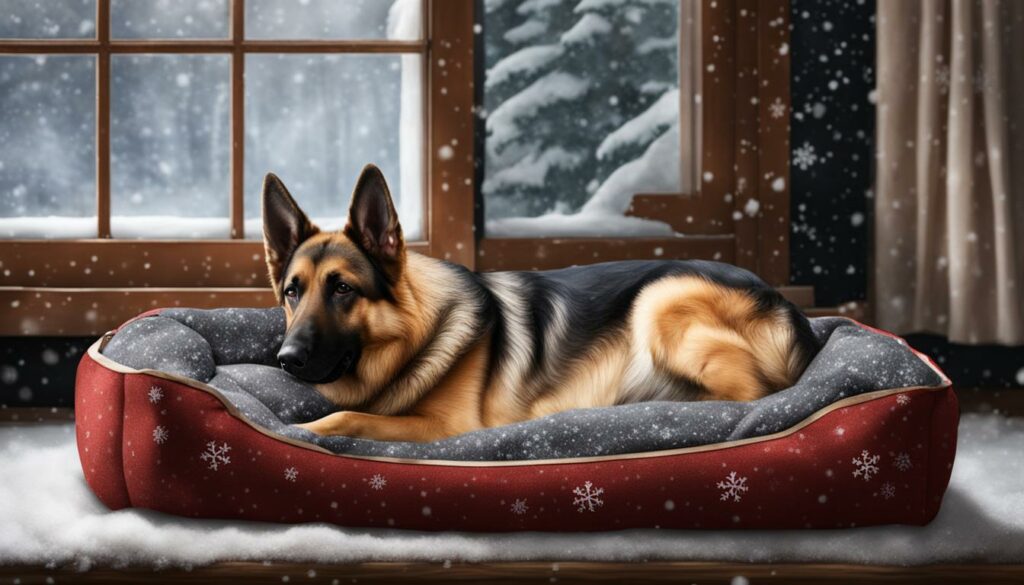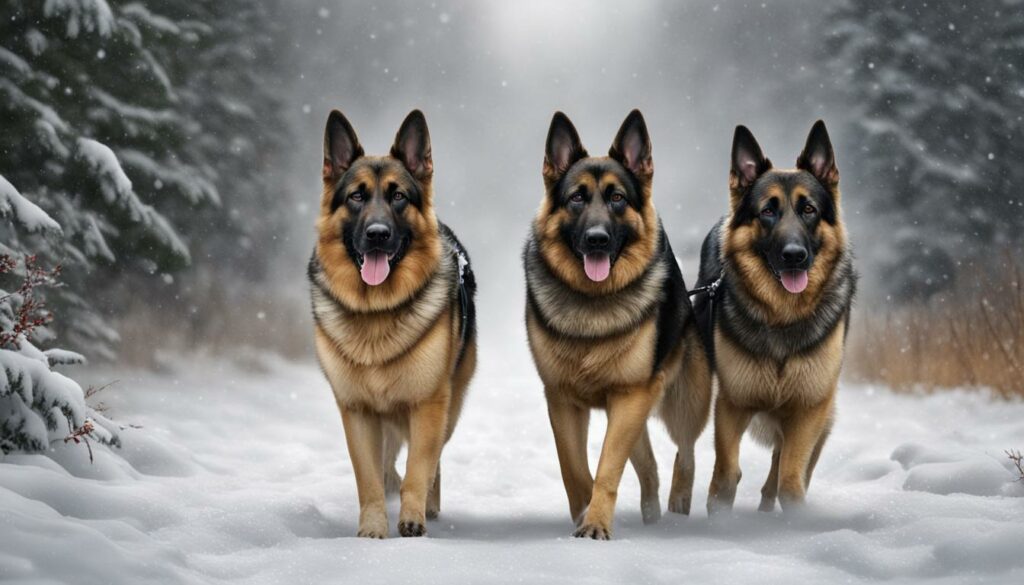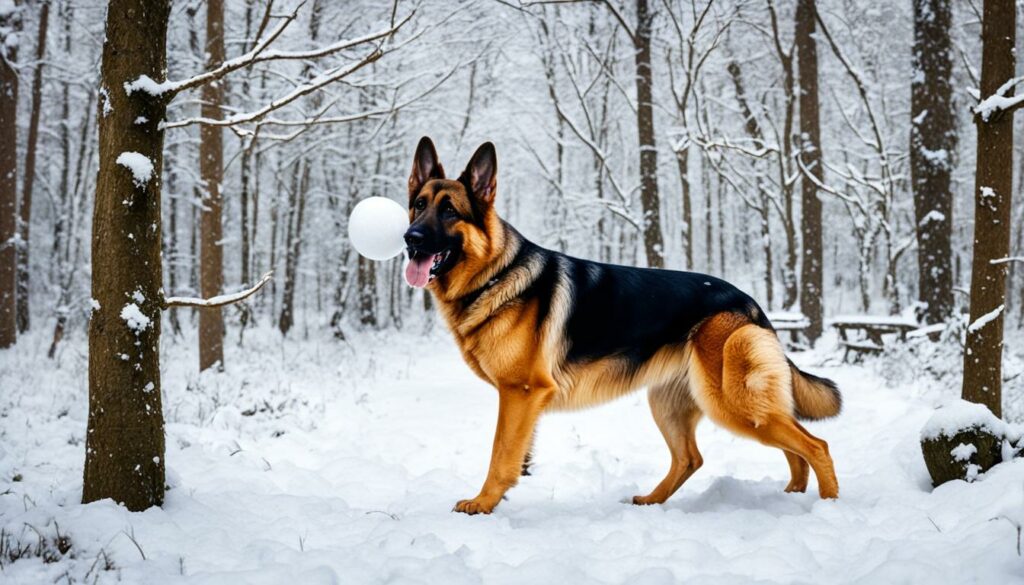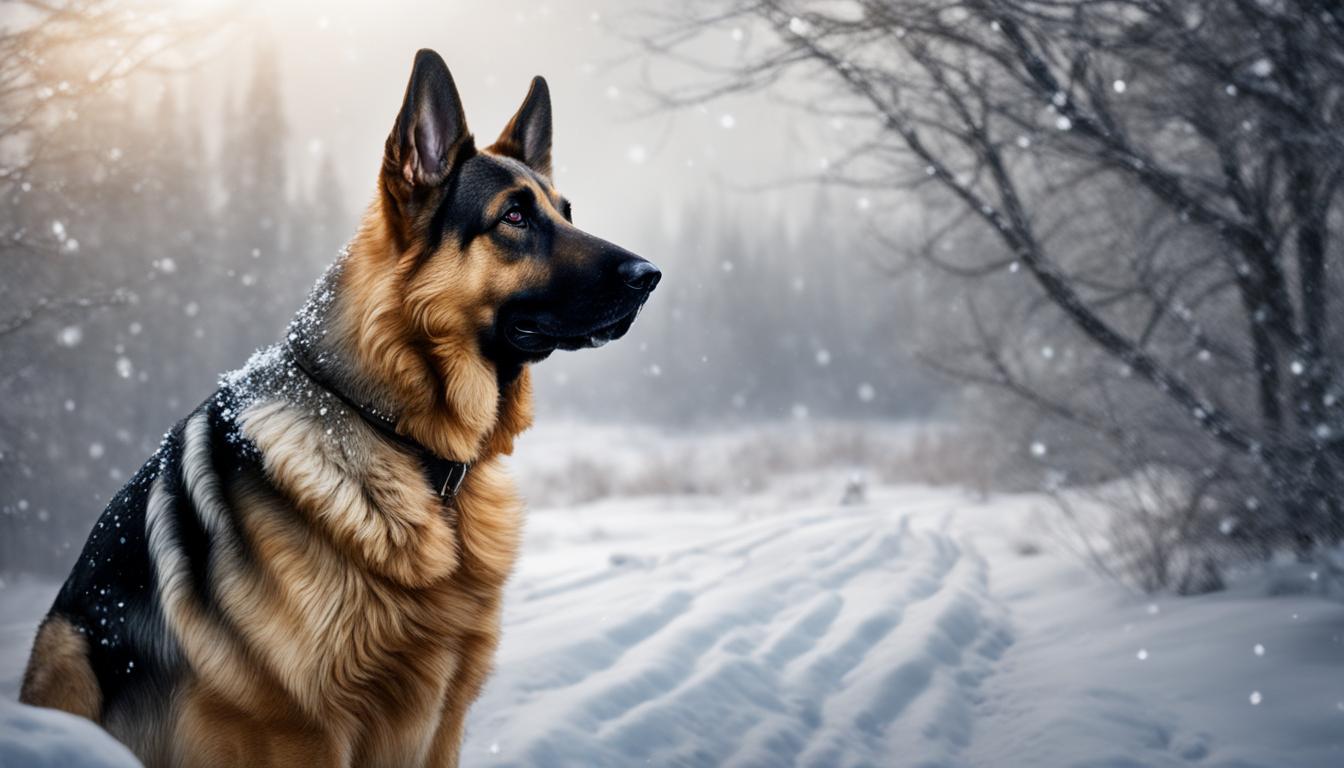🐾 Paw-some Partnership Alert! 🐾
As a pack of German Shepherd enthusiasts at MixGermanShepherd.com, we're always sniffing out the best products for our furry friends. Guess what? When you fetch something from Amazon through our links, we earn a little treat! 🦴
German Shepherds, with their majestic appearance and loyal nature, are not immune to the effects of cold weather. While these incredible canines have a double-coated fur that provides some insulation, they can still feel the chill in certain climates or environments. As responsible pet owners, it’s crucial to understand how cold weather affects German Shepherds and learn how to keep them warm and comfortable during the colder months.
Key Takeaways:
- German Shepherds can feel cold in certain climates or environments.
- Observing signs of discomfort is crucial to determine if your German Shepherd is feeling cold.
- Puppies are more sensitive to the cold and require extra care.
- Providing warm shelter, coats, and monitoring their behavior are essential in protecting German Shepherds in cold weather.
- Engaging in winter activities with your German Shepherd can be fun and stimulating for both of you.
Understanding German Shepherds’ Cold Tolerance
German Shepherds have a natural ability to withstand cold temperatures due to their unique coat structure. Their double-coated fur provides excellent insulation, helping to keep them warm in moderate cold conditions. However, it’s important to remember that even with their thick fur, German Shepherds can still feel the cold in extreme temperatures.
Observing your German Shepherd’s behavior and recognizing signs of discomfort is crucial to understanding their cold tolerance. If you notice your dog shivering, seeking warmth, or exhibiting any other signs of discomfort, it’s a clear indication that they may be feeling cold. This is especially important to remember when it comes to puppies, as they are more sensitive to the cold than adult German Shepherds and thus require extra care.
To ensure your German Shepherd’s comfort during the winter months, there are several steps you can take:
- Provide Warm Shelter: Create a cozy and well-insulated space for your German Shepherd to retreat to. This can include a doghouse with extra insulation or even bringing them indoors during particularly cold weather.
- Use Protective Gear: Consider investing in a high-quality winter coat or sweater designed specifically for large breeds like German Shepherds. These garments provide an extra layer of warmth and protection against the cold.
- Limit Exposure to Low Temperatures: While German Shepherds can handle colder weather, it’s important to limit their time outside in extreme cold conditions. Being exposed to low temperatures for extended periods can be uncomfortable and potentially harmful to your dog’s health.
By following these measures, you can promote your German Shepherd’s well-being and help them stay comfortable throughout the winter season.
German Shepherd Cold Tolerance Chart
Below is a chart that outlines the cold tolerance levels of German Shepherds based on different temperature ranges:
| Temperature Range (°F) | Temperature Range (°C) | Cold Tolerance Level |
|---|---|---|
| 45-60 | 7-15.6 | Moderate |
| 30-45 | -1-7 | Low |
| Below 30 | Below -1 | High |
It’s important to note that these temperature ranges are general guidelines, and individual dogs may have varying sensitivity to cold weather. Always monitor your German Shepherd closely and adjust their care accordingly.
Protecting German Shepherds in Cold Weather

To keep German Shepherds comfortable in cold weather, it’s important to take certain measures that ensure their well-being. Here are some essential tips:
1. Warm Coats or Sweaters
German Shepherds have a double coat that provides insulation, but in extreme cold, they may still need additional warmth. Choose warm coats or sweaters specifically designed for large breeds to keep them cozy during chilly outings.
2. Limit Outdoor Time
Extreme cold weather can be harsh on your German Shepherd’s health. It’s crucial to limit their time outside in frigid temperatures to prevent the risk of hypothermia. Frequent breaks indoors can help maintain their body temperature.
3. Access to Warm Shelter
Ensure that your German Shepherd has access to a warm and insulated shelter, such as a heated dog house or a designated indoor space. This provides them a safe haven to escape from the cold.
4. Monitor Behavior and Signs of Cold
Watch for signs of discomfort, such as shivering, seeking warmth, or lethargy, as these may indicate that your German Shepherd is feeling cold. It’s essential to monitor their behavior closely and make adjustments accordingly.
5. Warm Bedding
Provide your German Shepherd with warm bedding to help them stay comfortable and cozy during the cold weather. A soft and insulated bed, preferably elevated from the floor, can ensure that they are protected from the cold ground.
6. Bring Indoors if Necessary
If the temperature drops to extreme levels or your German Shepherd shows signs of discomfort despite protective measures, it’s best to bring them indoors. Keeping them in a warm and controlled environment will help them stay safe and comfortable.
Remember, the well-being of your German Shepherd should always be a top priority, particularly in cold weather. By following these tips and providing them with the necessary care, you can ensure that they feel comfortable and protected even in the chilliest of temperatures.
Walking German Shepherds in the Winter

Walking your German Shepherd in the winter can be a delightful experience for both you and your furry friend. However, it’s crucial to take certain precautions to ensure their comfort and well-being in colder temperatures.
When venturing out with your German Shepherd, always consider the temperature and wind chill factor. Avoid prolonged walks when the temperature falls between 0-45°F (-18 to 7°C). This range can be uncomfortable for your dog and may increase their risk of hypothermia or frostbite.
During your winter walks, pay close attention to your German Shepherd’s behavior. Watch for signs of discomfort or coldness, such as shivering, lifting their paws frequently, or trying to seek warmth. These indications suggest that your dog may be feeling the cold and it’s time to head back inside to provide them with cozy shelter.
In addition to monitoring their behavior, make sure to protect your German Shepherd’s paws during winter walks. Cold surfaces and ice can be harsh on their sensitive paw pads. Consider using dog booties or a protective paw balm to prevent cracking and irritation.
Remember, every dog is unique, and their tolerance to cold weather may vary. Pay attention to your German Shepherd’s individual needs and adjust your walking routine accordingly. If your dog seems uncomfortable or excessively cold during shorter walks, it might be best to keep them indoors and engage in alternative activities to keep them mentally and physically stimulated.
Ultimately, the key to walking German Shepherds in the winter is to strike a balance between exercise and their safety. Keep an eye on the weather conditions, be mindful of your dog’s behavior, and prioritize their well-being.
Exploring the winter wonderland with your German Shepherd can be a joyous experience. However, it’s important to prioritize their comfort, health, and safety. By taking the necessary precautions, you can create wonderful memories with your loyal companion while enjoying the beauty of the winter season.
Enjoying Winter Activities with German Shepherds

Winter is a magical time to bond with your German Shepherd and make lasting memories in the snow. Engaging in outdoor activities not only provides physical exercise but also mental stimulation, keeping your furry friend happy and healthy. Here are some exciting games and activities to enjoy with your German Shepherd in the winter wonderland:
1. Fetch
Playing fetch in the snow can be a thrilling experience for both you and your German Shepherd. Watch as they bound through the fluffy white powder to retrieve the ball, their excitement contagious. Be sure to use brightly colored toys or ones that contrast against the snow to make them more visible. Remember, safety always comes first, so choose an open space without any obstacles or hazards.
2. Hide and Seek
Test your German Shepherd’s sniffing skills with a game of hide and seek in the snow. While they stay put, find a hiding spot and call their name. Watch as they eagerly seek you out, their nose working overtime to track your scent. The snowy landscape adds an extra layer of challenge and fun to this classic game.
3. Sled Pulling
German Shepherds are strong and athletic, making them perfect sled pullers. Harness them up to a sled (designed for dogs) and let them experience the thrill of pulling you along in the snow. This activity not only provides exercise but also taps into their natural instincts and gives them a job to do. Remember to start slowly and gradually increase the weight and duration to avoid overexertion.
4. Building Snowmen
Get creative and build a snowman together with your German Shepherd. This activity allows you to bond while being artistic and playful. Your furry friend will enjoy the tactile sensation of the snow and their involvement in constructing a snowman. Don’t forget to capture the moment with some adorable photos!
5. Snowball Fight
Engage in a friendly snowball fight with your German Shepherd. This activity combines physical activity with a bit of friendly competition. Throw snowballs for them to catch or watch as they excitedly pounce on the snowy projectiles. It’s a playful and entertaining game that will surely make you both giggle.
These winter activities provide a wonderful opportunity to embrace the joy of the season while strengthening the bond with your German Shepherd. Remember to prioritize their safety and comfort throughout the activities, always ensuring they stay warm and hydrated. So, grab your gloves, bundle up, and embrace the snowy adventures with your loyal companion!
The Resilience of German Shepherds in Cold Weather

When it comes to cold weather, German Shepherds are known for their remarkable resilience. This breed has several characteristics that contribute to their ability to thrive in low temperatures, making them well-suited for chilly climates.
- Healthy Breed History: German Shepherds have a robust genetic background that originates from their working dog heritage. The breed was developed in Germany, where they were bred to withstand the harsh weather conditions of the region. This history has instilled natural adaptability and resilience in German Shepherds when it comes to cold weather.
- Strong Muscles and Size: German Shepherds are muscular and robust, with a well-built physique. Their strong muscles help generate heat, keeping them warm even in chilly temperatures. Additionally, their size, ranging from 60 to 100 pounds (27 to 45 kilograms), provides insulation and protection against the cold.
- Double Coat: One of the most distinctive features of German Shepherds is their double coat. This coat consists of a thick, dense undercoat and a longer, coarser outer coat. The combination provides excellent insulation and acts as a natural barrier against cold weather.
- Great Paw Circulation: German Shepherds have well-developed blood circulation in their paws, which helps keep their extremities warm. This circulation ensures that their paws receive adequate blood flow, preventing frostbite and maintaining overall comfort in cold weather conditions.
German Shepherds’ active nature also plays a role in their ability to handle cold weather. Their high energy levels keep them active and engaged, generating body heat to stay warm. This makes them ideal companions for outdoor activities in the snow, allowing both owner and dog to enjoy active winter adventures together.
Overall, German Shepherds have a natural resilience to cold weather, thanks to their healthy breed history, strong muscles, double coat, and active nature. However, despite their inherent tolerance to low temperatures, it’s important for owners to take proper care of their German Shepherds during cold weather conditions, ensuring they have warm shelter, appropriate outdoor gear, and monitoring for any signs of discomfort.
Conclusion
Keeping German Shepherds warm in cold weather is essential for their comfort and well-being. While these resilient dogs can tolerate low temperatures, it’s important to provide them with the proper care and protection to ensure their safety.
One of the key aspects of caring for German Shepherds in cold weather is providing them with warm shelter. Make sure their doghouse or indoor sleeping area is insulated and equipped with cozy bedding. Consider adding a heated pet pad or blanket to keep them extra warm on chilly nights.
Investing in a high-quality dog coat or sweater is another effective way to keep your German Shepherd warm during walks or outdoor activities. Look for coats specifically designed for large breeds, as they offer better coverage and insulation. Additionally, pay close attention to your dog’s behavior and, if they show signs of discomfort or shivering, it’s best to limit their time outdoors and bring them inside to warm up.
Lastly, engage in winter activities that are suitable for German Shepherds. They love to play in the snow and can enjoy games like fetch or hide and seek. Just be mindful of the duration of the activity and the temperature to avoid overexertion or exposing them to extreme cold.
By following these tips and prioritizing the well-being of your German Shepherd, you can ensure they stay warm, comfortable, and happy throughout the cold winter months.
FAQ
Do German Shepherds get cold?
Yes, German Shepherds can feel the cold in extreme temperatures, despite their double-coated fur.
How can I keep my German Shepherd warm in cold weather?
To keep your German Shepherd warm in cold weather, provide them with warm coats or sweaters, limit their time outside in extreme cold, and ensure they have access to a warm and insulated shelter.
Are puppies more sensitive to the cold than adult German Shepherds?
Yes, puppies are more sensitive to the cold than adult German Shepherds and require extra care and protection.
Can I walk my German Shepherd in winter?
Yes, you can walk your German Shepherd in winter, but it’s important to consider the temperature, wind chill, and duration of the walk. Avoid long walks in very cold temperatures and monitor your dog’s behavior for signs of discomfort or coldness.
What winter activities can I enjoy with my German Shepherd?
You can engage in outdoor activities like fetch, hide and seek, sled pulling, building snowmen, or having a snowball fight with your German Shepherd in the winter.
Are German Shepherds well-suited for cold weather?
Yes, German Shepherds are a resilient breed with a healthy breed history, strong muscles, double coat, and great paw circulation, making them well-suited for cold weather. They can thrive in cold temperatures and enjoy outdoor activities in the snow.
